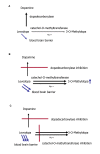Drug therapy in patients with Parkinson's disease
- PMID: 23211041
- PMCID: PMC3514092
- DOI: 10.1186/2047-9158-1-10
Drug therapy in patients with Parkinson's disease
Abstract
Parkinson`s disease (PD) is a progressive, disabling neurodegenerative disorder with onset of motor and non-motor features. Both reduce quality of life of PD patients and cause caregiver burden. This review aims to provide a survey of possible therapeutic options for treatment of motor and non motor symptoms of PD and to discuss their relation to each other. MAO-B-Inhibitors, NMDA antagonists, dopamine agonists and levodopa with its various application modes mainly improve the dopamine associated motor symptoms in PD. This armentarium of PD drugs only partially influences the onset and occurrence of non motor symptoms. These PD features predominantly result from non dopaminergic neurodegeneration. Autonomic features, such as seborrhea, hyperhidrosis, orthostatic syndrome, salivation, bladder dysfunction, gastrointestinal disturbances, and neuropsychiatric symptoms, such as depression, sleep disorders, psychosis, cognitive dysfunction with impaired execution and impulse control may appear. Drug therapy of these non motor symptoms complicates long-term PD drug therapy due to possible occurrence of drug interactions, - side effects, and altered pharmacokinetic behaviour of applied compounds. Dopamine substituting compounds themselves may contribute to onset of these non motor symptoms. This complicates the differentiation from the disease process itself and influences therapeutic options, which are often limited because of additional morbidity with necessary concomitant drug therapy.
Figures
Similar articles
-
Drug treatment of non-motor symptoms in Parkinson's disease.Expert Opin Pharmacother. 2002 Apr;3(4):381-8. doi: 10.1517/14656566.3.4.381. Expert Opin Pharmacother. 2002. PMID: 11934340 Review.
-
[Neuropsychiatric manifestations in Parkinson's disease].Psychiatriki. 2015 Apr-Jun;26(2):116-30. Psychiatriki. 2015. PMID: 26197101 Review. Greek, Modern.
-
A Stage-Based Approach to Therapy in Parkinson's Disease.Biomolecules. 2019 Aug 20;9(8):388. doi: 10.3390/biom9080388. Biomolecules. 2019. PMID: 31434341 Free PMC article. Review.
-
Medical management of levodopa-associated motor complications in patients with Parkinson's disease.CNS Drugs. 2007;21(8):677-92. doi: 10.2165/00023210-200721080-00005. CNS Drugs. 2007. PMID: 17630819 Review.
-
[Therapy of Parkinson disease. 1: Standard therapy of motor and non-motor symptoms].Fortschr Neurol Psychiatr. 1997 Aug;65(8):361-74. doi: 10.1055/s-2007-996341. Fortschr Neurol Psychiatr. 1997. PMID: 9378449 Review. German.
Cited by
-
α-Synuclein in Parkinson's disease: causal or bystander?J Neural Transm (Vienna). 2019 Jul;126(7):815-840. doi: 10.1007/s00702-019-02025-9. Epub 2019 Jun 25. J Neural Transm (Vienna). 2019. PMID: 31240402 Review.
-
Screening Anti-Parkinson's Disease Drugs in Living Mouse Brains via a Peroxynitrite-Activated Fluorescent Probe.Chem Biomed Imaging. 2024 Dec 20;3(5):301-309. doi: 10.1021/cbmi.4c00076. eCollection 2025 May 26. Chem Biomed Imaging. 2024. PMID: 40443559 Free PMC article.
-
P2X4 receptor participates in autophagy regulation in Parkinson's disease.Neural Regen Res. 2021 Dec;16(12):2505-2511. doi: 10.4103/1673-5374.313053. Neural Regen Res. 2021. PMID: 33907041 Free PMC article.
-
The effects of Parkinson's disease, music training, and dance training on beat perception and production abilities.PLoS One. 2022 Mar 8;17(3):e0264587. doi: 10.1371/journal.pone.0264587. eCollection 2022. PLoS One. 2022. PMID: 35259161 Free PMC article.
-
Effects of deep brain stimulation on rest tremor progression in early stage Parkinson disease.Neurology. 2018 Jul 31;91(5):e463-e471. doi: 10.1212/WNL.0000000000005903. Epub 2018 Jun 29. Neurology. 2018. PMID: 29959266 Free PMC article. Clinical Trial.
References
-
- Riederer P, Lachenmayer L, Laux G. Clinical applications of MAO-inhibitors. Curr Med Chem. 2004;11:2033–2043. - PubMed
-
- Parkinson Study Group: Effects of tocopherol and deprenyl on the progression of disability in early Parkinson's disease. The Parkinson Study Group. N Engl J Med. 1993;328:176–183. - PubMed
LinkOut - more resources
Full Text Sources


